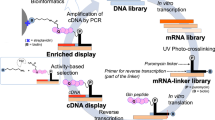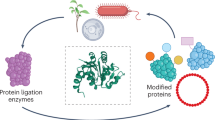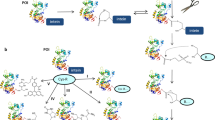Abstract
Enzyme-catalyzed peptide ligation is a powerful tool for site-specific protein bioconjugation, but stringent enzyme-substrate specificity limits its utility. We developed an approach for comprehensively characterizing peptide ligase specificity for N termini using proteome-derived peptide libraries. We used this strategy to characterize the ligation efficiency for >25,000 enzyme-substrate pairs in the context of the engineered peptide ligase subtiligase and identified a family of 72 mutant subtiligases with activity toward N-terminal sequences that were previously recalcitrant to modification. We applied these mutants individually for site-specific bioconjugation of purified proteins, including antibodies, and in algorithmically selected combinations for sequencing of the cellular N terminome with reduced sequence bias. We also developed a web application to enable algorithmic selection of the most efficient subtiligase variant(s) for bioconjugation to user-defined sequences. Our methods provide a new toolbox of enzymes for site-specific protein modification and a general approach for rapidly defining and engineering peptide ligase specificity.
This is a preview of subscription content, access via your institution
Access options
Access Nature and 54 other Nature Portfolio journals
Get Nature+, our best-value online-access subscription
$29.99 / 30 days
cancel any time
Subscribe to this journal
Receive 12 print issues and online access
$259.00 per year
only $21.58 per issue
Buy this article
- Purchase on Springer Link
- Instant access to full article PDF
Prices may be subject to local taxes which are calculated during checkout





Similar content being viewed by others
References
Liu, Y., Patricelli, M.P. & Cravatt, B.F. Activity-based protein profiling: the serine hydrolases. Proc. Natl. Acad. Sci. USA 96, 14694–14699 (1999).
Banghart, M., Borges, K., Isacoff, E., Trauner, D. & Kramer, R.H. Light-activated ion channels for remote control of neuronal firing. Nat. Neurosci. 7, 1381–1386 (2004).
Weerapana, E. et al. Quantitative reactivity profiling predicts functional cysteines in proteomes. Nature 468, 790–795 (2010).
Erlanson, D.A., Wells, J.A. & Braisted, A.C. Tethering: fragment-based drug discovery. Annu. Rev. Biophys. Biomol. Struct. 33, 199–223 (2004).
Ostrem, J.M., Peters, U., Sos, M.L., Wells, J.A. & Shokat, K.M. K-Ras(G12C) inhibitors allosterically control GTP affinity and effector interactions. Nature 503, 548–551 (2013).
Serafimova, I.M. et al. Reversible targeting of noncatalytic cysteines with chemically tuned electrophiles. Nat. Chem. Biol. 8, 471–476 (2012).
Junutula, J.R. et al. Site-specific conjugation of a cytotoxic drug to an antibody improves the therapeutic index. Nat. Biotechnol. 26, 925–932 (2008).
Lyon, R.P. et al. Self-hydrolyzing maleimides improve the stability and pharmacological properties of antibody-drug conjugates. Nat. Biotechnol. 32, 1059–1062 (2014).
Pleiner, T. et al. Nanobodies: site-specific labeling for super-resolution imaging, rapid epitope-mapping and native protein complex isolation. eLife 4, e11349 (2015).
Lin, S. et al. Redox-based reagents for chemoselective methionine bioconjugation. Science 355, 597–602 (2017).
Guimaraes, C.P. et al. Site-specific C-terminal and internal loop labeling of proteins using sortase-mediated reactions. Nat. Protoc. 8, 1787–1799 (2013).
Fernández-Suárez, M. et al. Redirecting lipoic acid ligase for cell surface protein labeling with small-molecule probes. Nat. Biotechnol. 25, 1483–1487 (2007).
Wu, P. et al. Site-specific chemical modification of recombinant proteins produced in mammalian cells by using the genetically encoded aldehyde tag. Proc. Natl. Acad. Sci. USA 106, 3000–3005 (2009).
Hooker, J.M., Esser-Kahn, A.P. & Francis, M.B. Modification of aniline containing proteins using an oxidative coupling strategy. J. Am. Chem. Soc. 128, 15558–15559 (2006).
Lang, K. et al. Genetically encoded norbornene directs site-specific cellular protein labelling via a rapid bioorthogonal reaction. Nat. Chem. 4, 298–304 (2012).
Dawson, P.E., Muir, T.W., Clark-Lewis, I. & Kent, S.B. Synthesis of proteins by native chemical ligation. Science 266, 776–779 (1994).
Muir, T.W., Sondhi, D. & Cole, P.A. Expressed protein ligation: a general method for protein engineering. Proc. Natl. Acad. Sci. USA 95, 6705–6710 (1998).
Henager, S.H. et al. Enzyme-catalyzed expressed protein ligation. Nat. Methods 13, 925–927 (2016).
Jacob, E. & Unger, R. A tale of two tails: why are terminal residues of proteins exposed? Bioinformatics 23, e225–e230 (2007).
Rosen, C.B. & Francis, M.B. Targeting the N terminus for site-selective protein modification. Nat. Chem. Biol. 13, 697–705 (2017).
MacDonald, J.I., Munch, H.K., Moore, T. & Francis, M.B. One-step site-specific modification of native proteins with 2-pyridinecarboxyaldehydes. Nat. Chem. Biol. 11, 326–331 (2015).
Nguyen, G.K.T. et al. Butelase 1 is an Asx-specific ligase enabling peptide macrocyclization and synthesis. Nat. Chem. Biol. 10, 732–738 (2014).
Abrahmsén, L. et al. Engineering subtilisin and its substrates for efficient ligation of peptide bonds in aqueous solution. Biochemistry 30, 4151–4159 (1991).
Frankel, B.A., Kruger, R.G., Robinson, D.E., Kelleher, N.L. & McCafferty, D.G. Staphylococcus aureus sortase transpeptidase SrtA: insight into the kinetic mechanism and evidence for a reverse protonation catalytic mechanism. Biochemistry 44, 11188–11200 (2005).
Schechter, I. & Berger, A. On the size of the active site in proteases. I. Papain. Biochem. Biophys. Res. Commun. 27, 497–502 (1967).
Schilling, O. & Overall, C.M. Proteome-derived, database-searchable peptide libraries for identifying protease cleavage sites. Nat. Biotechnol. 26, 685–694 (2008).
Renicke, C., Spadaccini, R. & Taxis, C. A tobacco etch virus protease with increased substrate tolerance at the P1′ position. PLoS One 8, e67915 (2013).
Mahrus, S. et al. Global sequencing of proteolytic cleavage sites in apoptosis by specific labeling of protein N termini. Cell 134, 866–876 (2008).
Shimbo, K. et al. Quantitative profiling of caspase-cleaved substrates reveals different drug-induced and cell-type patterns in apoptosis. Proc. Natl. Acad. Sci. USA 109, 12432–12437 (2012).
Chang, T.K., Jackson, D.Y., Burnier, J.P. & Wells, J.A. Subtiligase: a tool for semisynthesis of proteins. Proc. Natl. Acad. Sci. USA 91, 12544–12548 (1994).
Schilling, O. & Overall, C.M. Proteomic discovery of protease substrates. Curr. Opin. Chem. Biol. 11, 36–45 (2007).
Wells, J.A., Powers, D.B., Bott, R.R., Graycar, T.P. & Estell, D.A. Designing substrate specificity by protein engineering of electrostatic interactions. Proc. Natl. Acad. Sci. USA 84, 1219–1223 (1987).
Estell, D.A. et al. Probing steric and hydrophobic effects on enzyme-substrate interactions by protein engineering. Science 233, 659–663 (1986).
Takeuchi, Y. et al. Molecular recognition at the active site of subtilisin BPN': crystallographic studies using genetically engineered proteinaceous inhibitor SSI (Streptomyces subtilisin inhibitor). Protein Eng. 4, 501–508 (1991).
Hedstrom, L., Szilagyi, L. & Rutter, W.J. Converting trypsin to chymotrypsin: the role of surface loops. Science 255, 1249–1253 (1992).
Estell, D.A., Graycar, T.P. & Wells, J.A. Engineering an enzyme by site-directed mutagenesis to be resistant to chemical oxidation. J. Biol. Chem. 260, 6518–6521 (1985).
Nuijens, T. et al. Engineering a diverse ligase toolbox for peptide segment condensation. Adv. Synth. Catal. 358, 4041–4048 (2016).
Hornsby, M. et al. A high through-put platform for recombinant antibodies to folded proteins. Mol. Cell. Proteomics 14, 2833–2847 (2015).
Fellouse, F.A. et al. High-throughput generation of synthetic antibodies from highly functional minimalist phage-displayed libraries. J. Mol. Biol. 373, 924–940 (2007).
Pan, Y. et al. Determination of equilibrium dissociation constants for recombinant antibodies by high-throughput affinity electrophoresis. Sci. Rep. 6, 39774 (2016).
Saxon, E. & Bertozzi, C.R. Cell surface engineering by a modified Staudinger reaction. Science 287, 2007–2010 (2000).
Wiita, A.P., Hsu, G.W., Lu, C.M., Esensten, J.H. & Wells, J.A. Circulating proteolytic signatures of chemotherapy-induced cell death in humans discovered by N-terminal labeling. Proc. Natl. Acad. Sci. USA 111, 7594–7599 (2014).
Crawford, E.D. & Wells, J.A. Caspase substrates and cellular remodeling. Annu. Rev. Biochem. 80, 1055–1087 (2011).
Xiao, Q., Zhang, F., Nacev, B.A., Liu, J.O. & Pei, D. Protein N-terminal processing: substrate specificity of Escherichia coli and human methionine aminopeptidases. Biochemistry 49, 5588–5599 (2010).
Voss, M., Schröder, B. & Fluhrer, R. Mechanism, specificity, and physiology of signal peptide peptidase (SPP) and SPP-like proteases. Biochim. Biophys. Acta 1828, 2828–2839 (2013).
The UniProt Consortium. UniProt: the universal protein knowledgebase. Nucleic Acids Res. 45, D158–D169 (2017).
Gibson, D.G. et al. Enzymatic assembly of DNA molecules up to several hundred kilobases. Nat. Methods 6, 343–345 (2009).
Wells, J.A., Ferrari, E., Henner, D.J., Estell, D.A. & Chen, E.Y. Cloning, sequencing, and secretion of Bacillus amyloliquefaciens subtilisin in Bacillus subtilis. Nucleic Acids Res. 11, 7911–7925 (1983).
Zheng, L., Baumann, U. & Reymond, J.-L. An efficient one-step site-directed and site-saturation mutagenesis protocol. Nucleic Acids Res. 32, e115 (2004).
Milo, R. & Phillips, R. How big is the “average” protein? in Cell Biology by the Numbers http://book.bionumbers.org/how-big-is-the-average-protein/ (2015).
Giansanti, P., Tsiatsiani, L., Low, T.Y. & Heck, A.J.R. Six alternative proteases for mass spectrometry-based proteomics beyond trypsin. Nat. Protoc. 11, 993–1006 (2016).
Coin, I., Beyermann, M. & Bienert, M. Solid-phase peptide synthesis: from standard procedures to the synthesis of difficult sequences. Nat. Protoc. 2, 3247–3256 (2007).
Braisted, A.C., Judice, J.K. & Wells, J.A. Synthesis of proteins by subtiligase. Methods Enzymol. 289, 298–313 (1997).
Wiita, A.P., Seaman, J.E. & Wells, J.A. Global analysis of cellular proteolysis by selective enzymatic labeling of protein N-termini. Methods Enzymol. 544, 327–358 (2014).
Reverter, D. & Lima, C.D. Preparation of SUMO proteases and kinetic analysis using endogenous substrates. Methods Mol. Biol. 497, 225–239 (2009).
Acknowledgements
We thank S. Coyle, Z. Hill, M. Hornsby, H. Huang, O. Julien, P. Lee, D. Sashital, L. Pack, A. Stewart, H. Tran, K. Wypysniak and members of the Wells laboratory for helpful discussions. We thank P. Lee and M. Hornsby (University of California, San Francisco) for the αGFP rAb expression vector, S. Pollock (University of California, San Francisco) for the HEK-293T-GFP cell line, and H. Tran (University of California, San Francisco) for the subtiligase E. coli expression vector. This work was supported by NIH grant 5R01GM081051-09 and the Harry and Dianna Hind Professorship in Pharmaceutical Sciences (to J.A.W.). A.M.W. is a Merck Fellow of the Helen Hay Whitney Foundation (F-1112) and holds a Career Award at the Scientific Interface from the Burroughs Wellcome Fund (1017065).
Author information
Authors and Affiliations
Corresponding author
Ethics declarations
Competing interests
A.M.W., J.A.W. and the Regents of the University of California have filed a patent application (US Provisional Patent Application No. 62/398,898) related to engineered subtiligase variants.
Supplementary information
Supplementary Text and Figures
Supplementary Results, Supplementary Tables 1–8 and Supplementary Figures 1–16 (PDF 4219 kb)
Supplementary Data Sets
Supplementary Data Sets 1–78 (ZIP 53900 kb)
Rights and permissions
About this article
Cite this article
Weeks, A., Wells, J. Engineering peptide ligase specificity by proteomic identification of ligation sites. Nat Chem Biol 14, 50–57 (2018). https://doi.org/10.1038/nchembio.2521
Received:
Accepted:
Published:
Issue Date:
DOI: https://doi.org/10.1038/nchembio.2521
This article is cited by
-
Recent advances in chemical protein synthesis: method developments and biological applications
Science China Chemistry (2024)
-
Nature-inspired protein ligation and its applications
Nature Reviews Chemistry (2023)
-
The roles of intracellular proteolysis in cardiac ischemia–reperfusion injury
Basic Research in Cardiology (2023)
-
Substrate multiplexed protein engineering facilitates promiscuous biocatalytic synthesis
Nature Communications (2022)
-
Spatially Resolved Tagging of Proteolytic Neo-N termini with Subtiligase-TM
The Journal of Membrane Biology (2021)



